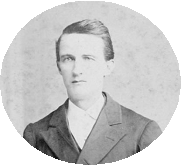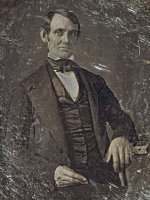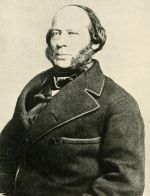This is a section of the book Tallmans In The Civil War. This page covers Solomon A. Tallman. You can read on, or click here to browse the rest of the book.
Solomon A. Tallman
I guess I’m both partial about and proud of my great- grandfather. Born the year before his brother Trustum in 1843 he as well his father and siblings moved to a 240 acre farm in Chautauqua County, New York not far from Chautauqua Lake; and which Prendergast Creek runs through the middle of. Educated in local schools at 17 he would make a decision to move to Minnesota with his older brother Joseph and his wife prior to the war. His brother Joseph and wife Julia were both educators in Mower County. Unable to find suitable work he made the decision to join the Union Army and mustered into Company “K” of the Fourth Minnesota Infantry on October 21, 1861 at Ft. Snelling, MN. His brother Joseph was his guardian and wrote a letter giving his permission. His Volunteer paper described him as being 5’–5” in height with a light complexion, blue eyes and brown hair. After completion of training at Ft. Snelling they went to Benton Barracks located in north St. Louis County, Missouri 4-5 miles from the City of St. Louis. The facility, located on the outskirts of St. Louis,
could accommodate 30,000 soldiers and contained a mile of barracks, warehouses, cavalry stables, parade grounds, and a large military hospital.
May the 2nd they departed south on the Mississippi onboard the John J. Roe one of thirty such steamboats there for troop ferrying. They were
paid there two months’ wages in gold and silver the last such specie pay
until the end of the war. The Regiment under command of Lt. Col. John E. Tourtellote left the landing at sundown heading south to join General Henry Halleck before the battle of Corinth, Mississippi. May 6th they departed the steamship at Paris Landing on the Tennessee River. There they drilled till the 13th when they boarded the steamboats Glendale and Silver Landing arriving at Hamburg Landing, Tennessee early on the morning of the 14th. From there they marched towards Corinth and were joined by other regiments and attached to the 1st Brigade, 2nd Division soon to be renamed the 3rd Division of the Army of the Mississippi. It was during the battle of Corinth that Company “K’s” commander Capt. Robert P. Mooers was shot and killed. Lt. Ira N. Morrill then became its Commander until the end of the war.
They would participate in the Battle of Corinth and then with General Ulysses S. Grants’ Central Mississippi Campaign before moving to Milliken’s Bend Louisiana. The Fourth was part of General James B. McPherson’s XVII Corp. They then would take part in the Battles of Port Gibson, Raymond, Jackson and Champion’s Hill just before participating in the Siege of Vicksburg.
After the surrender of Vicksburg they spent time doing garrison duties there as well as Memphis and Chattanooga. Eventually by years end relocating to Huntsville, Alabama which was set up as a large supply base for Grant who by this time was promoted to Command the Military Division of the Mississippi. The Division consisted of the Departments of Ohio, Tennessee and Cumberland. Under the new re-organization Brig. Gen. John Eugene Smith was now commander of the 4th Minn., and the 59th Ind., 48th Ind., 18th Wis. and 63rd Ill. On January 1st in Huntsville almost all the men from the original Regiment re-enlisted for 3 more years. It makes me proud knowing Solomon could have resigned from any further duty when his three years were up, but, instead re- enlisted for another three or the duration of the war. Particularly seeing 3 officers and 58 enlisted killed in action with another 3 officers and 175 enlisted who died of disease just from his regiment. On the 20th while at Huntsville the Fourth had traveled now 1600 miles by steamboat, 100 miles by railroad and marched over 800 miles. In March of 1864 Grant became General of the Army and Maj. Gen. William T. Sherman took over charge of the Division.
On March 5th of 1864 the Fourth started a furlough, while heading back to Minnesota, the train they were on was rear-ended on its way to Nashville, resulting in 7 killed, 22 wounded, with 20 cars and a locomotive burned. April 22nd the Regiment returned to Huntsville, during this time Sherman planned and commenced his Atlanta Campaign.
1864 must have been a very hot summer it was probably in June when Solomon was sunstruck as several other men were as well while marching on this Campaign. During the Campaign Gen. J. E. Smith assigned Colonel Tourtellote and the Regiment duty as part of a garrison and supply depot that was established at Altoona, Georgia. The garrison consisted of the Fourth, Ninety Third Illinois, seven companies of the Eighteenth Wisconsin, the Twelfth Wisconsin’s Light Artillery and 15 men of the Ohio Fifth Calvary. On October 5th they were involved in a severe battle while there. Troops under the command of Confederate Gen. Samuel G. French were desperate for rations and supplies and made a concerted attack on them. A total of 6 officers were killed, and 136 enlisted, 330 wounded, of which the Fourth sustained 3 officers wounded, 11 killed, and 30 wounded.
On November 12th they left Allatoona and marched about 333 miles to Savannah in rear guard of Sherman’s army, they were in only 1 skirmish and marched in only 3 days of rain. At Savannah Capt. Morrill resigned “our campaign has ended and we are out of the woods in every sense”
January 19th 1865 Sherman’s army left Savannah and headed north to Campaign through the Carolina’s and attempt to force Confederate Gen. Joseph E. Johnston’s surrender. They marched 463 miles from Savannah to Goldsboro, North Carolina having skirmished in Charleston, South Carolina along the way. At Bentonville, North Carolina they again acted in reserve of the battle there. By the time they had reached Raleigh, Generals Lee & Johnston surrendered and President Lincoln had been assassinated. As of April 28th they had now been 8 months from their last pay. Now that the war was over they were to march an easy 10 miles a day to Richmond, Virginia, but, of course that didn’t happen due to bad weather and roads. They marched from 4 to 20 miles a day. After reviews in Richmond and spending time visiting the attractions of the Confederate Capital they marched to Washington to take part in the Grand Review which lasted several days. They were still not discharged, but, sent to Louisville, Kentucky to await further orders departing Washington by train to Parkersburg, West Virginia where they boarded the steamboat “Champion” arriving in Louisville on June 4, 1865. July 9th the Regiment was mustered out and the men received their discharge papers and final pay on August 5th in St. Paul, Minnesota.
After the war Solomon returned to Chautauqua County and married Harriet A. Skinner they divorced after 10 years of marriage and he then married Laura Case. Solomon was a carpenter and for many years built homes in Jamestown and Chautauqua. Eventually settling on a small farm he worked as a finish carpenter for the Pullman Rail Car Co. in Brocton, NY. On his passing he left his wife Laura, son Henry W. and daughter Helen “Bessie”. He was buried in Mayville Cemetery, Mayville, NY.
Copyright © 2013 Jon L. Tallman, all rights reserved
Next: Trustum C. Tallman and Henry Merritt Tallman
American Civil War Story - Home









New! Comments
Have your say about what you just read! Leave me a comment in the box below.